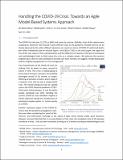| dc.contributor.author | de Weck, Olivier L | |
| dc.contributor.author | Krob, Daniel | |
| dc.contributor.author | Lefei, Li | |
| dc.contributor.author | Lui, Pao Chuen | |
| dc.contributor.author | Rauzy, Antoine | |
| dc.contributor.author | Zhang, Xinguo | |
| dc.date.accessioned | 2021-04-27T16:05:11Z | |
| dc.date.available | 2021-04-27T16:05:11Z | |
| dc.date.issued | 2020-08 | |
| dc.date.submitted | 2020-07 | |
| dc.identifier.issn | 1098-1241 | |
| dc.identifier.issn | 1520-6858 | |
| dc.identifier.uri | https://hdl.handle.net/1721.1/130529 | |
| dc.description.abstract | The COVID-19 pandemic has caught many nations by surprise and has already caused millions of infections and hundreds of thousands of deaths worldwide. It has also exposed a deep crisis in modeling and exposed a lack of systems thinking by focusing mainly on only the short term and thinking of this event as only a health crisis. In this paper, authors from several of the key countries involved in COVID-19 propose a holistic systems model that views the problem from a perspective of human society including the natural environment, human population, health system, and economic system. We model the crisis theoretically as a feedback control problem with delay, and partial controllability and observability. Using a quantitative model of the human population allows us to test different assumptions such as detection threshold, delay to take action, fraction of the population infected, effectiveness and length of confinement strategies, and impact of earlier lifting of social distancing restrictions. Each conceptual scenario is subject to 1000+ Monte-Carlo simulations and yields both expected and surprising results. For example, we demonstrate through computational experiments that maintaining strict confinement policies for longer than 60 days may indeed be able to suppress lethality below 1% and yield the best health outcomes, but cause economic damages due to lost work that could turn out to be counterproductive in the long term. We conclude by proposing a hierarchical Computerized, Command, Control, and Communications (C4) information system and enterprise architecture for COVID-19 with real-time measurements and control actions taken at each level. | en_US |
| dc.language.iso | en | |
| dc.publisher | Wiley | en_US |
| dc.relation.isversionof | http://dx.doi.org/10.1002/sys.21557 | en_US |
| dc.rights | Creative Commons Attribution-Noncommercial-Share Alike | en_US |
| dc.rights.uri | http://creativecommons.org/licenses/by-nc-sa/4.0/ | en_US |
| dc.source | Other repository | en_US |
| dc.title | Handling the COVID‐19 crisis: Toward an agile model‐based systems approach | en_US |
| dc.type | Article | en_US |
| dc.identifier.citation | de Weck, Olivier et al. "Handling the COVID‐19 crisis: Toward an agile model‐based systems approach." Systems Engineering 23, 5 (August 2020): 656-670 © 2020 Wiley Periodicals LLC | en_US |
| dc.contributor.department | Massachusetts Institute of Technology. Institute for Data, Systems, and Society | en_US |
| dc.relation.journal | Systems Engineering | en_US |
| dc.eprint.version | Original manuscript | en_US |
| dc.type.uri | http://purl.org/eprint/type/JournalArticle | en_US |
| eprint.status | http://purl.org/eprint/status/NonPeerReviewed | en_US |
| dc.date.updated | 2021-04-23T17:26:15Z | |
| dspace.orderedauthors | de Weck, O; Krob, D; Lefei, L; Lui, PC; Rauzy, A; Zhang, X | en_US |
| dspace.date.submission | 2021-04-23T17:26:16Z | |
| mit.journal.volume | 23 | en_US |
| mit.journal.issue | 5 | en_US |
| mit.license | OPEN_ACCESS_POLICY | |
| mit.metadata.status | Complete | |

